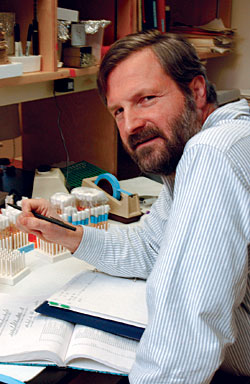Dartmouth-Hitchcock Medical Center Development
Where the puck is going to be
By Barbra Alan
When asked to divulge the secret of his playing strategy, ice hockey great Wayne Gretzky used to say, "I skate where the puck is going to be, not where it's been."
Although Gretzky was inspired at figuring out where the puck was going to be, something he probably couldn't have envisioned was that his words would one day be applied to genetics research at Dartmouth Medical School. But they are surprisingly appropriate.

|
In recent years, the world has witnessed many celebrated advances in genetics—the sequencing of the human genome being the most momentous one. At the same time, geneticists at Dartmouth have been engaged in similarly compelling— albeit not quite so high-profile— research in genetics.
Exciting discoveries
Members of the Dartmouth faculty are successfully unraveling some of the most important puzzles of genetics. Take the biological clock, for example. Synchronized by daily cycles of light and dark, this cellular timepiece controls virtually every activity within living things, from sleep patterns to breathing.
But exactly how it works is still a mystery. To help answer that question, Jay Dunlap, Ph.D.—the chair of DMS's Department of Genetics and a researcher internationally acclaimed for his pioneering work on the biological clock—has focused his career on identifying what he calls its "cogs and gears." Using the fungus Neurospora, a simple organism with a biological clock that is functionally equivalent to the clocks in more complex organisms, Dunlap and his team are advancing their understanding of how living things keep track of time.
Their research recently revealed that a single protein called White Collar-1 does double duty: it not only perceives light, but it also turns on the central component of the clock —the frequency gene. This important discovery made the cover of the renowned journal Science in August of 2002 and has since then helped Dartmouth geneticists to identify other proteins that also influence biological clocks.
|
Even more recently, Dunlap— together with his DMS colleague Jennifer Loros, Ph.D., and two scientists from the University of Manchester in England—made yet another breakthrough in the quest to understand the workings of the biological clock. They discovered that an unusual form of RNA, known as antisense, appears to regulate core timing genes in Neurospora's biological clock. The results of their research, which reveal a previously unrecognized link between antisense RNA and biological timing, were featured in the February 27, 2003, issue of the journal Nature.
But exactly what do these advances mean to humankind? With their increased understanding about chronobiology, these investigators are closing in on identifying remedies for conditions ranging from delayed sleep phase syndrome to seasonal affective disorder, as well as scores of other ailments that result from a malfunction of the biological clock.
Other Dartmouth geneticists are earning plaudits for their basic research, too. The discovery of microsized RNA molecules earned the American Association for the Advancement of Science's prestigious Newcomb Cleveland Prize for Victor Ambros, Ph.D., and Rosalind Lee. (See page 6 in this issue for more on this prize, which Ambros and Lee shared with research teams from MIT's Whitehead Institute and Germany's Max Planck Institute).
Ambros and Lee's research provides new insight into gene expression— the process by which the information coded in DNA is transferred to messenger RNA and then translated into proteins.
Why is this important? Understanding how protein production is controlled during gene expression is essential to understanding the mysteries of all life processes—including the development of disease.
Clinical applications
Just as important as making discoveries in genetics is figuring out how to bring them to clinical settings. One hurdle is the fact that many physicians now in practice did their training when genetics was not much more than an abstract concept. DMS epidemiologist Joseph Henderson, M.D., has figured out a way to help health-care providers who don't have specialized expertise in genetics learn the essentials of this fast-growing field. He has developed an interactive program called "Genetics in Clinical Practice."
This virtual course in genetics can be viewed either on CD or via the Web; it uses state-of-the-art interactive multimedia to make continuing medical education convenient, effective, and even fun.

|

|
|
Doing the same in the
world of science—peering
into the future—are Dartmouth
Medical School faculty
members like geneticist
Jay Dunlap (right) and epidemiologist
Joe Henderson
(at left in the photo below). |
The program is set in an onscreen "clinic," where the user can interact with several simulated patients. Case discussions and counseling demonstrations are led by various renowned geneticists. Learners also gain an understanding of how genetic testing is done, how to counsel patients, and how to interpret the results of genetic tests.
The future
The sequencing of the human genome in 1999 ushered in a new, exciting era in medicine. Every day, genetics research yields valuable information that will lead to new ways to treat, cure, and ultimately prevent the diseases that afflict humankind.
Therapeutic applications for all these discoveries appear to be just around the corner, and it's the work of investigators like Dunlap and his distinguished colleagues on the Dartmouth faculty that will put them within grasp.
Dunlap's face will most likely never grace a box of Wheaties, as Wayne Gretzky's has, but there's no question that he and his colleagues are skating in the scientific world to "where the puck is going to be."
There are no shortcuts to any
place worth going.
— Beverly Sills
Partners in research
Dartmouth Medical School's Department of Genetics owes its existence in part to generous initial and ongoing support from donors such as Jennifer Brock and the Howard Hughes Medical Institute (HHMI). An endowment gift from the Jennifer M. Brock Lead Annuity Trust and a major grant from the HHMI have enabled DMS to recruit top geneticists from all over the world. In addition, they have contributed to building valuable research models using subjects such as mice, which are genetically and physiologically similar to humans.
A high-quality research environment needs a stable base of funding to allow for long-term planning and to ensure that sufficient resources are available so exciting new lines of research can be explored as opportunities arise. Endowment funds in particular can help the Department of Genetics continue to make significant contributions in advancing knowledge in the life sciences.
Private philanthropy complements the primary source of research funding—the federal government. While the Department of Genetics has had tremendous success in competing for federal grants, private donations offer flexibility that the government or other funding agencies do not. For example, private dollars can go toward work that federal funds cannot, as well as to areas where government or other funding sources cannot respond in a timely manner. In addition, endowment funds provide the support that gifted young investigators with great potential often need to jumpstart their research careers.
Endowments have the ability to truly make a difference—to the investigators engaged in this critical work, but most important to the patients who will ultimately benefit from their discoveries.
Barbra Alan is assistant director of development communications at DHMC.
If you would like to offer any feedback about this article, we would welcome getting your comments at DartMed@Dartmouth.edu.
